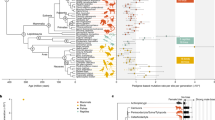Abstract
If germline mutations arise because of replication errors, the mutation rate may differ between males and females given that they differ in their number of germ cell divisions. As males of many higher organisms produce more gametes than females, this has led to the idea of “male-driven evolution.” The extent of such male bias to the mutation rate is currently debated. For human some recent data suggest a very low bias, at a factor 1.7 only, while other approaches have given values of αm (the male-to-female mutation rate ratio) of 5, which is more close to what might be expected from male and female germ cell biology. Comparative analyses of sex-specific mutation rates in other organisms may be necessary for understanding the generality of an effect of sex and the number of germline DNA replications on the mutation rate. In this study we estimate for the first time sex-specific mutation rates in fish. Comparing the intronic substitution rates of the autosomal GH-2 gene and its duplicated Y-linked and male-specific copy GH-2Y (447–468 bp of each gene), we estimate αm to be 5.35–6.60 in salmonid fish of the genus Oncorhynchus. To the observations previously made among mammals and birds, this adds evidence from another class of vertebrates showing that a majority of mutations are of paternal origin. This would suggest that replication errors play a major role for the generation of new mutations.
Similar content being viewed by others
Author information
Authors and Affiliations
Rights and permissions
About this article
Cite this article
Ellegren, H., Fridolfsson, AK. Sex-Specific Mutation Rates in Salmonid Fish . J Mol Evol 56, 458–463 (2003). https://doi.org/10.1007/s00239-002-2416-z
Received:
Accepted:
Issue Date:
DOI: https://doi.org/10.1007/s00239-002-2416-z




